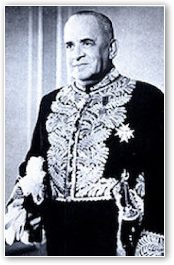Paul Comtois — a martyr for the Eucharist
- FATHER RAYMOND J. DE SOUZA
Paul Comtois, the former lieutenant governor of Quebec, was a different kind of martyr.
 Paul Comtois
Paul Comtois1895-1966
The age of the martyrs has returned: more Christians were martyred in the 20th century than the previous 19 centuries combined. And our own time is marked by frequent massacres of Christians.
The latest was on Friday in Yemen, where 16 people were shot and killed at a nursing home for destitute elderly people run by the Mother Teresa's sisters. Among the dead were four Missionaries of Charity. You might think that the massacre of religious women who care for the poorest of the poor might be novel, but this is the second time Missionaries of Charity have been killed in Yemen — three sisters were gunned down in 1998.
Paul Comtois, the former lieutenant governor of Quebec, was a different kind of martyr. He was not killed by the hatred of others; rather, he was motivated by his own love of Christ. He might be considered a martyr for the Eucharist.
I might have missed it, but it didn't seem as though anything was done last month, by either church or state, to mark the 50th anniversary of his death on Feb. 22, 1966. And his story is one that needs to be told.
Perhaps former prime minister John Diefenbaker had something of a preference for pious French Canadians. In 1959, he recommended to Queen Elizabeth that Georges Vanier be appointed governor general, which Her Majesty assented to at a special meeting of Diefenbaker's cabinet held in her presence in Halifax in 1959.
Two years after Vanier's appointment, Diefenbaker recommended the appointment of Comtois, then a cabinet minister from Quebec, as lieutenant governor. A long time farmer and community leader from rural Quebec, Comtois represented the best of his generation of Quebecers. He was involved in his local caisse populaire, agricultural associations and religious fraternities, including the League of the Sacred Heart and the Knights of Columbus. Having run for the federal Conservatives in the 1930 election and been defeated by a single vote, he won the seat in the elections of 1957 and 1958. After three years in cabinet, he took up his vice regal duties, which, by all accounts, he carried out admirably.
Such was his devotion to his Catholic faith that he requested permission from the cardinal archbishop of Quebec to have the Eucharist kept in his chapel at the official residence, Bois-de-Coulonge in Quebec City. The cardinal was initially reluctant, as that permission is not usually granted for private homes, but he eventually granted it, asking Comtois to personally assure the proper custody and care of the Eucharist. Comtois' daily routine included family prayer and he ended his days in the chapel before the Eucharist, the sacrament which Catholics and Orthodox believe is the real presence of Christ.
He reached the chapel, already engulfed in flames, but managed to make it to the tabernacle and remove the pyx containing the Body of Christ.
Just after midnight on Feb. 22, 1966, the Comtois family were awakened by a raging fire. The tale is told by writer Andrew Cusack:
"Having been assured that all his family and guests had escaped the inferno, the seventy-year-old Paul Comtois returned to the private chapel in which he visited the Lord every evening before bed to save the Blessed Sacrament from the desecrating fire. He reached the chapel, already engulfed in flames, but managed to make it to the tabernacle and remove the pyx containing the Body of Christ. Leaving the chapel, he descended the staircase which collapsed about him, and the Lieutenant-Governor was burned alive in the inferno. The fire in which Paul Comtois died was so hot that the first firemen on the scene could not approach within a hundred feet of the building."
If you are unfamiliar with the story of the faith-filled death of Paul Comtois, it's not because you forgot. He died at the height of the Quiet Revolution, when Quebecers themselves were enthusiastically putting a torch to their religious heritage. The secular inferno was such that the mainstream press simply did not report the circumstances of the lieutenant governor's death and the Catholic press was embarrassed by it. So his act of heroism was treated as something to be hidden. And it was.
I don't know how many governors general or lieutenant governors have died in office, let alone those who have died in an act of heroic devotion. Perhaps Comtois is the only one. If a lieutenant governor had died attempting to rescue a cat in a flaming building, do you not suppose we would all know about it? That it would be taught in school textbooks? That there would be a stamp commemorating the anniversary? That there would be animal shelters named after him and fundraising dinners held to raise awareness?
It is not necessary to share Comtois' faith in the Eucharist to admire the testimony that he rendered with his death. We should remember, or, as they might put it in Quebec, je me souviens.
 This is Meaghen Gonzalez, Editor of CERC. I hope you appreciated this piece. We curate these articles especially for believers like you.
This is Meaghen Gonzalez, Editor of CERC. I hope you appreciated this piece. We curate these articles especially for believers like you.
Please show your appreciation by making a $3 donation. CERC is entirely reader supported.

Acknowledgement
 Father Raymond J. de Souza, "Paul Comtois — a martyr for the Eucharist." National Post, (Canada) March 8, 2016.
Father Raymond J. de Souza, "Paul Comtois — a martyr for the Eucharist." National Post, (Canada) March 8, 2016.
Reprinted with permission of the National Post and Fr. de Souza.
The Author
Father Raymond J. de Souza is the founding editor of Convivium magazine.
Copyright © 2016 National Post



